
The Complete Guide To String Action Height For Electric, Acoustic, Bass and Classical Guitars
What Is String Action Height?
String action height refers to the distance between the bottom of your guitar’s strings and the top of the frets, measured at the 12th fret. This measurement is vital for ensuring your guitar is comfortable to play, free of buzzing, and capable of producing the desired tone.
When Should I Check My Guitar's String Action Height?
- If you notice changes in playability or tone.
- Seasonal changes and fluctuations in humidity can affect your guitar’s setup, so it’s recommended that you check it every few months.
- After you adjust your truss rod.
- After changing your strings.
What Causes My String Action To Change?
- Changes in Humidity and Temperature: Wood is sensitive to environmental conditions. Fluctuations in humidity and temperature can cause the wood in the instrument’s neck and body to expand or contract, leading to changes in string action.
- Neck Relief (Truss Rod Adjustment): The truss rod is a metal rod inside the neck of the guitar that can be adjusted to control the amount of curvature (relief) in the neck. Over time, the neck can naturally bend, which affects string action. Adjusting the truss rod can correct these changes.
- Wear and Tear: Regular instrument use can cause wear on the frets, nuts, and bridges. As these components wear down, they can affect the string height. For instance, worn frets can lower the action, while a worn nut can cause inconsistent string height across the fretboard.
- String Gauge Changes: Switching to a different gauge (thickness) of strings can affect the tension on the neck and subsequently change the action. Heavier gauge strings exert more tension, potentially increasing the action, while lighter gauge strings exert less tension, potentially lowering the action.
- Bridge and Saddle Movement: The bridge and saddles can shift or settle over time on some guitars, especially those with floating bridges (such as certain electric guitars with tremolo systems). This can alter the string action, either raising or lowering it.
- Changes in the Nut: The nut can wear down over time, causing the strings to sit lower in their slots. Having the strings sit lower in their slots can lower the action, especially near the first few frets. Conversely, the action can be higher than desired if the nut slots are not deep enough.
- Instrument Settling: New instruments or those that have undergone significant repairs might undergo a “settling” period, during which the wood and components adjust to the tension of the strings. This can lead to changes in action over time as the instrument stabilizes.
- Improper Storage: Storing an instrument in conditions that are too dry, humid, hot, or cold can cause the wood to warp or the components to shift, affecting the string action. Proper storage in a controlled environment is crucial for maintaining consistent action.
- Bridge/Saddle Adjustment Screws: On instruments with adjustable bridges and saddles, the screws can sometimes loosen or tighten due to vibrations from playing or changes in environmental conditions, leading to changes in string height.
- String Tension Changes: Frequent changes in tuning (e.g., from standard tuning to drop tuning) can affect the overall tension on the neck and body, potentially altering the string action.
What Are The Issues With High String Action?
- Increased Difficulty in Playing: High string action requires more force to press the strings down to the fretboard, which makes playing physically more demanding, especially for beginners or players with less finger strength.
- Reduced Speed And Agility: The additional effort needed to press the strings can slow down a player’s performance. Complex Chords and challenging solos become more complicated to execute cleanly and quickly.
- Intonation Issues: High action can cause intonation problems. When strings are pressed down, they stretch more than usual, causing notes to sound sharp and making it difficult to play in tune, especially in higher positions on the neck.
- Hand, Wrist Or Arm Injury: Constantly exerting extra force can lead to hand and finger strain or even more severe injuries like tendinitis or carpal tunnel syndrome. This is especially concerning for musicians who practice and perform frequently.
What Are The Benefits And Issues With Low String Action?
- Low string action helps make the guitar easier and less tiring to play because it takes less force to press down on a string with low action versus high action, where there is more distance between the string and the fret.
- Lower action can help maintain more accurate intonation because the strings are not stretched as much when pressed down. This helps ensure that notes and chords sound in tune across the entire fretboard.
- The issue with having low string action is that it’s more likely to cause fret buzz when playing, leading to a buzzy and uneven sound.
What Tools Do I Need To Adjust My String Action Height?
- A String Action Gauge to measure the string action height at the 12th fret
- A capo to hold down the string at the 1st fret.
- Depending on guitar type, you will need a compatible screwdriver or Allen wrench. All potential screwdriver types can be found in MusicNomad’s wrench set.
- A Radius Gauge to check and adjust your string radius.
-
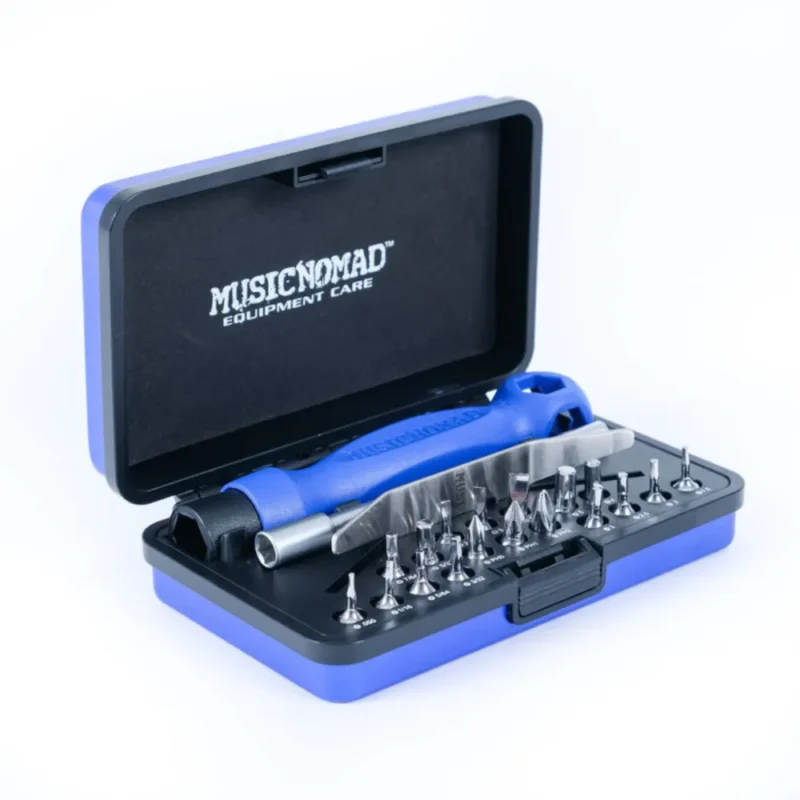
Premium Guitar Tech Screwdriver and Wrench Set
MN229$49.99 -
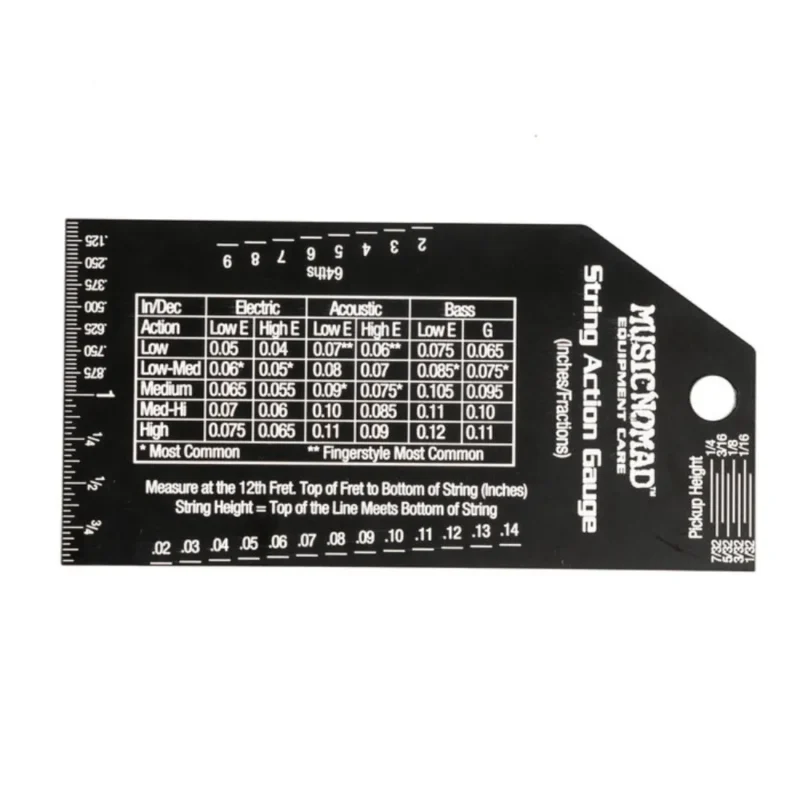
Precision String Action Gauge
MN602$17.99 -
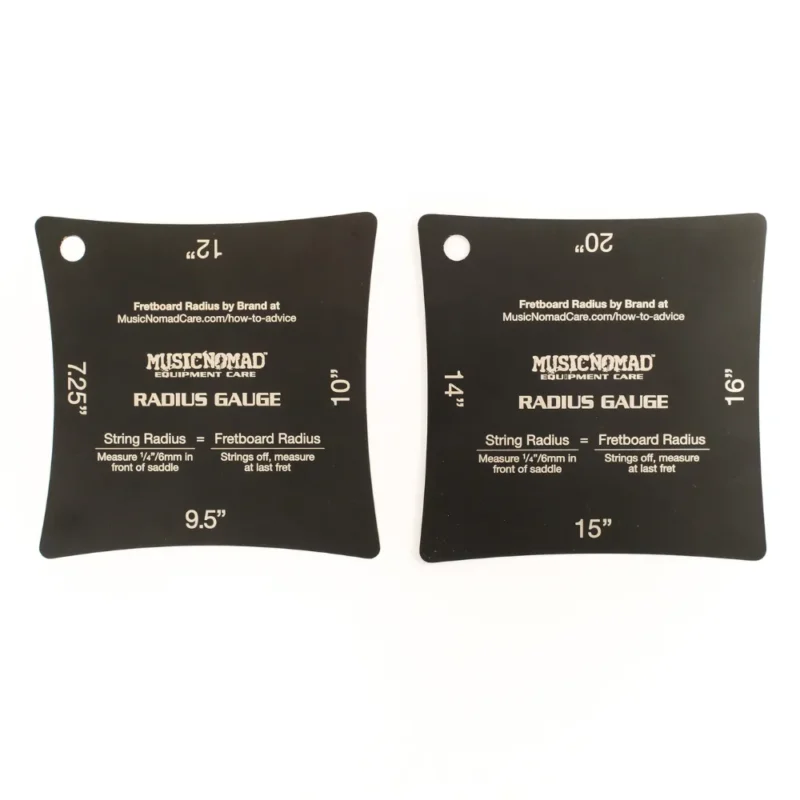
Precision Radius Gauge Set – 2 Pak
MN603$17.99
What Are The Most Common Action Heights?
For Electric Guitars
- 6 String: Low E String (0.060″/1.50mm) | High E String (0.050″/1.25 mm)
- 7 String: Low B String (0.065″/1.65mm) | High E String (0.050″/1.25mm)
- 8 String: Low F# String (0.070″/1.75mm) | High E String (0.050″/1.25mm)
For Bass Guitars
- 4 String: E String (0.085″/2.15mm) | G String (0.075″/1.90mm)
- 5 String: B String (0.090″/2.25mm) | G String (0.075″/1.90mm)
- 6 String: B String (0.090″/2.25mm) | C String (0.075″/1.90mm)
For Acoustic Guitars
- Low E String (0.090″/2.30mm) | High E String (0.075″/1.90mm)
For Classical Guitars
- Low E String (0.120″/3.00mm) | High E String (0.100″/2.30mm)
What Is The Process For Measuring String Action Height On A Guitar?
- Tune Your Guitar: Make sure your guitar is properly tuned before measuring. Tuning affects string tension, which in turn affects action height. If you are performing MusicNomad’s Keep it Simple Setup, make sure you have already adjusted the truss rod and set the string radius for instruments with fixed-radius bridges.
- Position the Guitar: Ensure it is in a playing position for the most accurate measurement. You will check the string action for the Low E first and the High E second.
- Use A Pick Capo: Use a capo or MusicNomad’s pick capo to hold the low E string against the 1st fret.
- Locate the 12th Fret: The 12th fret is typically where action height is measured.
- Place the Gauge: Slide the String Action Gauge under the low E string at the 12th fret. The gauge has several markings for different measurement units (inches, millimeters, & 64ths). Choose the unit you are most comfortable with.
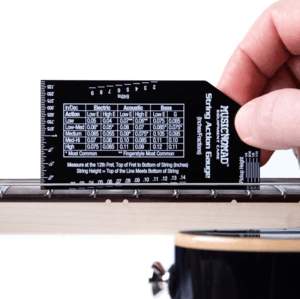
- Read the Measurement: Looking at the string height measuring lines under the string, find which line meets the bottom of the string.
- Compare to Desired Action: Compare your measurements to the recommended action height on the gauge. You may need to adjust if your action is too high or too low.
- Repeat the Process: Repeat these steps for a high E string to measure the current string action height.
Do I Set String Action Before Or After The Radius Of Strings?
If your instrument has individually adjustable saddles, you will have to set the string action before the radius of the strings. If your instrument has a fixed saddle, you will set the string action after setting the string radius.
Why Capo The First Fret When Measuring And Adjusting Your String Height?
In the flow, string height comes before nut height. Our measurements are based on using the pick capo at the first fret. Since the nut has not been addressed yet, you would use a height reference point that could be off. The first fret is a fixed height to adjust from.
How Do I Adjust the String Action Height for an Electric Guitar?
For Individual Saddles
On a guitar with individually adjustable saddles, you will use a screwdriver or Allen wrench to raise or lower the saddles with the small saddle screws that go through the saddles themselves. This MusicNomad screwdriver set has everything you need.Take the correct screwdriver and turn the screw to the right to raise the saddle, or turn it to the left to lower the saddle. If you have a guitar with six individually adjustable saddles, each saddle usually has two screws, and you’ll want to ensure that the saddle bottoms are parallel to the bridge plate and one screw is NOT higher than the other.
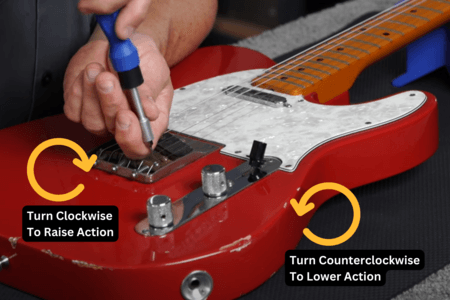
After you set the outer two strings, you will then set the radius of the inner four strings to their correct string action height.
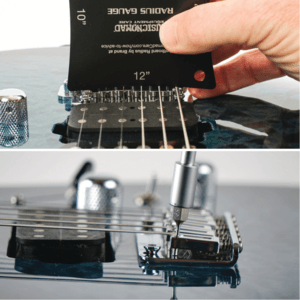
For Fixed Saddles - Check Radius First
Set your inner strings heights by using the radius gauge that matches your fretboard radius. Set the gauge on the strings about 1/4” in front of the saddles, then adjust your inner saddles so that the strings all touch the gauge.
Having selected the gauge that matches the fretboard radius, you will file your saddles until all strings contact the gauge. You will need to file the highest strings first with a slight downward angle towards the back of the bridge. Be careful and go slow. If you go too far, you will have to readjust all other saddles to compensate. Some saddles may be too low to achieve a perfect radius, so then a replacement bridge may be in order.
After setting the appropriate radius of the strings to set the proper string action height, then you will measure and either raise or lower the fixed bridge. Tune-o-matic and Fixed Bridge saddles are supported on either end by a post. Raise and lower that bridge by turning those posts up or down, which raises or lowers the bridge.
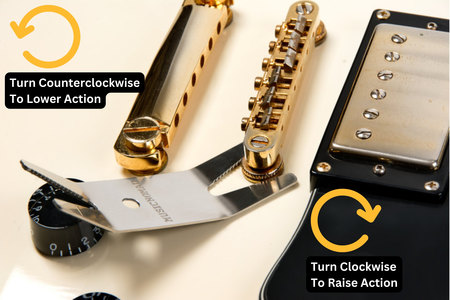
These guitars typically have thumb wheels that you can grip and turn clockwise to lower the bridge or raise it counterclockwise. Sometimes with full string tension on, it can be hard to grip these with your fingers, and you may not be able to even turn them by hand with full string tension.
You need to loosen your strings to relieve some of the tension on the bridge so that you can turn them by hand, or you can use the spanner wrench from the screwdriver set to grip the thumb wheel. You can turn it counterclockwise with one end of the wrench, or you can turn it clockwise with the other end of the wrench. Some tune-o-matic bridges, most Epiphone or import models, have a screwdriver recess at the top of the post. You can use a flat-bladed screwdriver bit to access it.
You can turn the post up or down that way and don’t have to use the thumb wheels. Turn the adjuster wheels up or down until your bridge is in the location that achieves the proper action at the 12th fret.
How Do I Adjust The String Action Height For An Acoustic Or Classical Guitar?
A saddle adjustment on an acoustic guitar is more complicated than a saddle adjustment on an electric guitar because you have to remove material from the saddle to adjust physically. It’s possible to make these adjustments at home with a piece of sandpaper on a block, or if you have an old piece of tile or a piece of glass, you can put some sandpaper down and sand the bottom of the saddle to adjust your action height. Due to the complexity of lowering the saddle on an acoustic guitar, we recommend you take it to a qualified repair shop for help. To adjust the action on Fixed Saddles found on most acoustic guitars, go to musicnomadcare.com/setup-hub or watch this video
How Do I Adjust the String Action Height for a Bass Guitar?
The process for adjusting is the same as an electric guitar. Use a proper Allen wrench to be able to adjust the saddles. You want to make sure that your saddles stay parallel to the bridge of the bass. You don’t want them at angles; instead, have the pressure be evenly pressed down on both saddle screws.
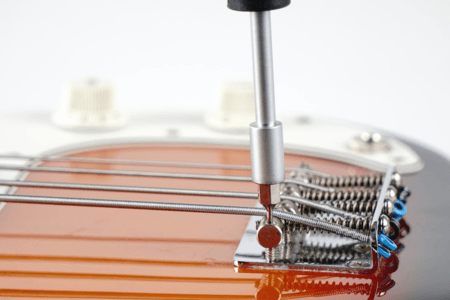
Do New Guitars Have High String Action?
New guitars typically have their string actions set high to avoid any fret buzz when they are played. If you pick up a guitar from a guitar store and test-play it, you might not be able to judge whether or not the action is high or low, but you would tell right off the bat if you had fret buzz. With the action set high, fret buzz becomes less likely. However, you may have to lower the string action yourself after purchase.
